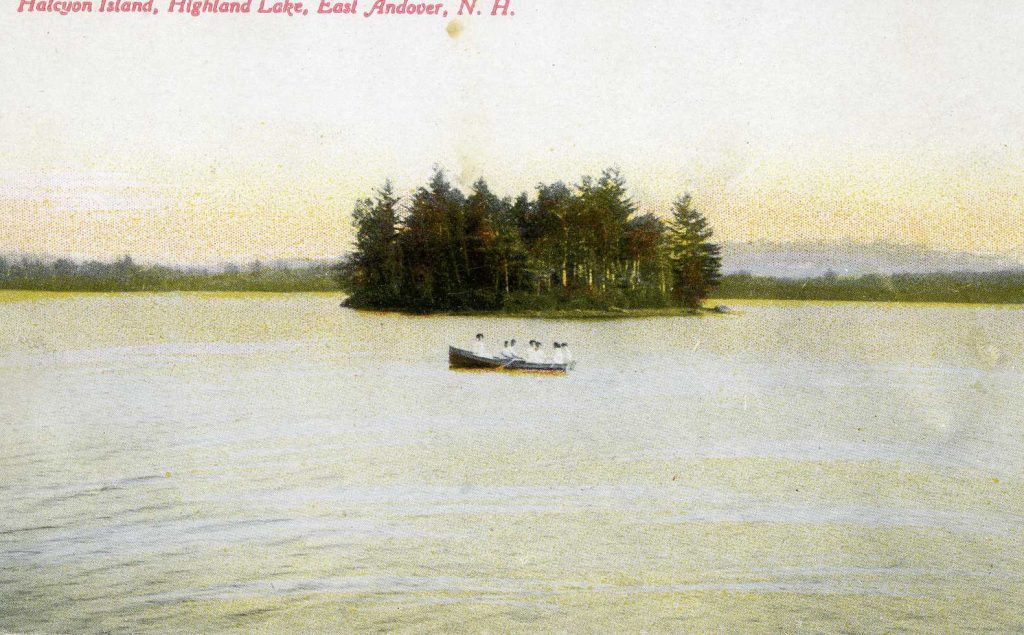
Around the turn of the 20th century, many city dwellers escaped the summer heat by vacationing in the country. Some even spent the whole summer, staying with local farmers, where they became known as “summer boarders.” Andover was one of these destination towns.
This article (edited and condensed) appeared in the July 28, 1893, in Merrimack Journal. It was saved by W. A. Bachelder, who for years clipped Andover-related articles from the newspaper, which he then pasted into a series of books that are now kept in the Andover Historical Society archives.
“Strangers who come here to spend the summer, hardly learn in one season of all the attractive places to visit that are not far away. Of course the Lake for boating and fishing with its four miles of shore, including Halcyon Island, and the beautiful beach of pure white sand for bathing purposes, all receive an early introduction.
”Artist Hill in Mr. Friend Bailey’s pasture [Fulton’s today, on Emery Road] gives a charming view of the village and lake and surrounding country, as does also the road by the late Col. B. F. Scribner’s [Chase Hill Road, later the Chaffees’]. Marston Hill, at the home of Mr. Hiram Cross and son [Rose family today, on Emery Road], offers a fine view of Webster Lake, Franklin Falls, Tilton, and The Arch, and much of the country in that direction. There is a road leading toward Flaghole, where the first settler in town planted his cabin in 1761, and farther on is a good place to look upon the State House in Concord.
”Birch Avenue, on the road above Mr. Frank W. Dickerson’s [former Poor Farm on Tucker Mountain Road] has been pronounced by Ex-Governor Moody Currier to be the finest display of birches of any he had seen.
”Then there is Cilley Hill above the old William H. Weare farm [today’s Sam Hill Road], which will give a look at the Franconia and White Mountain range with Mt. Washington towering over all.
”If anyone wants wild and majestic scenery, let him go to the falls on the mountain brook where the water rushes over the solid ledge in three successive leaps after forcing itself beneath hanging crags and overhanging trees for a mile or more. Then tramp up this brook till tired, then a climb up “Bulk Head” on the side of Ragged Mountain will fill the soul with grand thoughts and the body with aches and pains enough to last a week or more.
”Ragged Mountain itself is no mean eminence to stand upon and some deem it quite as interesting as the lordly Kearsarge, which of course should be visited early and often with a good jolly company and ample commissary stores. There are several other lakes, like Webster, Echo, and the shady banks of the Blackwater, including the bays, which are very fine places for picnics and all day rests.”
When this article was written in 1893, many farmers were still earning their living by raising sheep, the wool of which kept the mills in the cities running. The big sheep boom of earlier years, however, had reached its peak and was rapidly declining. In order to raise large flocks of sheep, the trees from the forests had been harvested, and the land turned into pastures. Gradually over the years, the trees grew back and, sadly, many of Andover’s 1893 vista points disappeared.
Happily, Highland Lake continues to be a pleasant place to visit in Andover! The postcard in the photo accompanying this article is addressed to Nellie Morey in East Andover. Nellie lived near Dyers Crossing and was my mother’s teacher at the Dyers Crossing School from 1914 to 1920. Nellie had given this card to my mother to use in a school project booklet, which was similar to this article, as it told about and showed many of the interesting places to see and visit in the Andover area.
The message reads: “Will you contribute a cake for the celebration tomorrow night? Fireworks at dark, followed by ice cream and cake free.” F. Severence (Florence Severance and Nellie Morey Emery were cousins.)